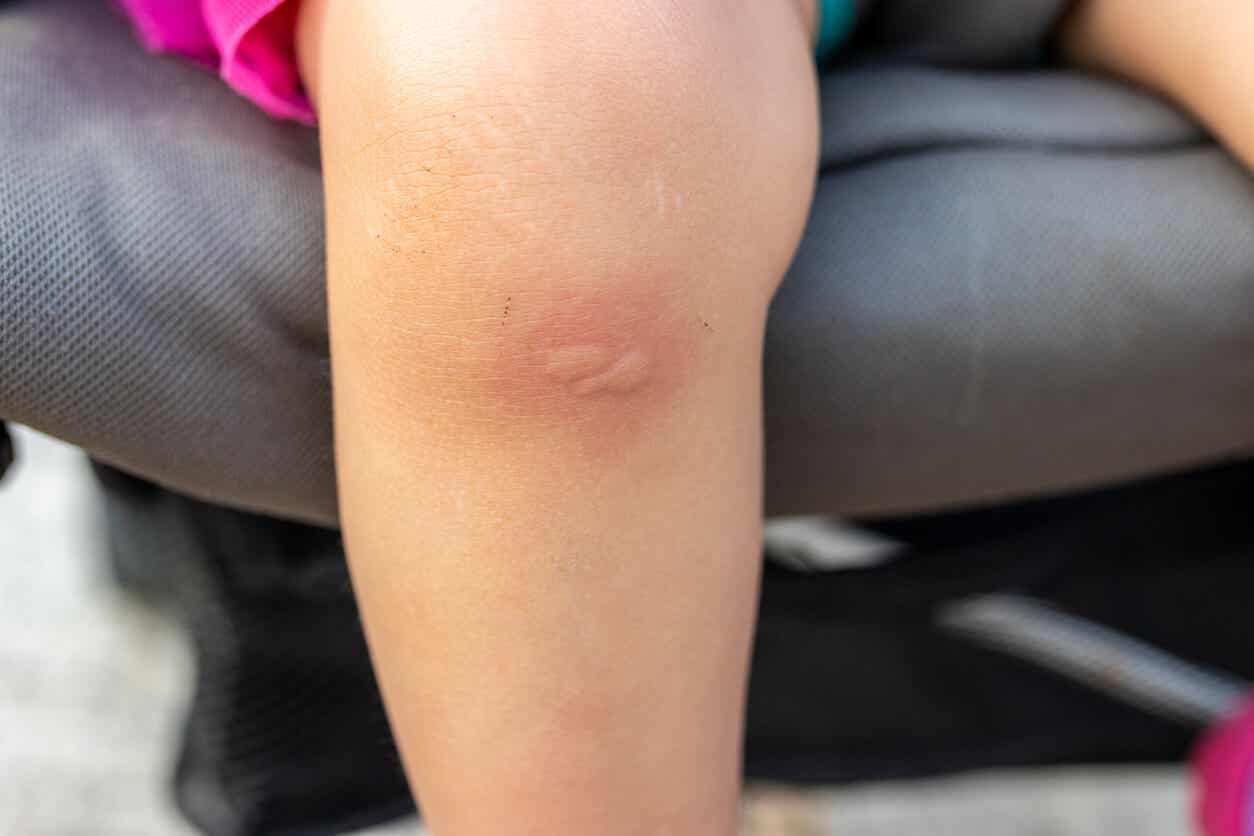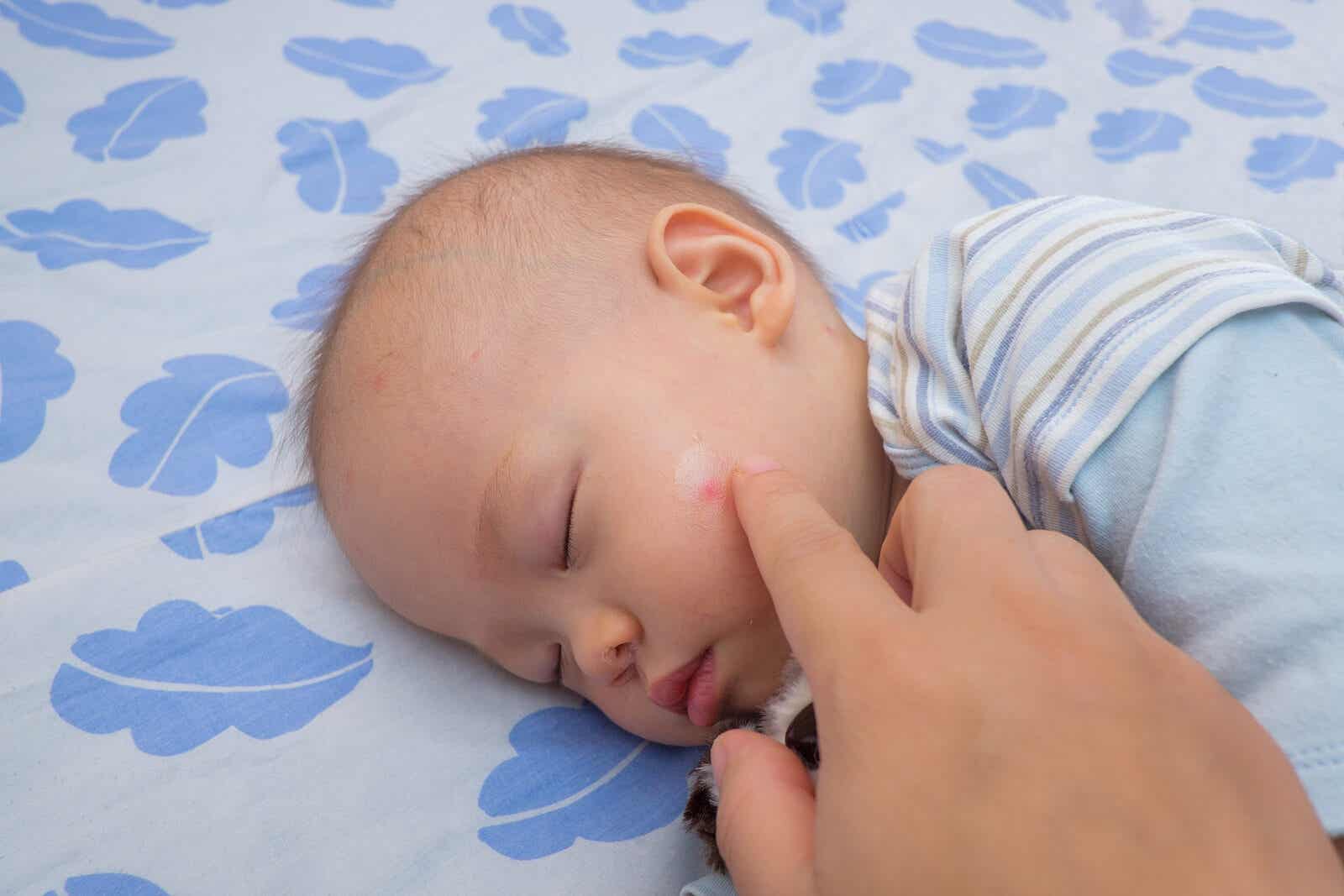What Is Prurigo Simplex in Children?


Written and verified by the dermatologist Maria del Carmen Hernandez
Infantile prurigo simplex is a common condition caused by an insect bite. It’s characterized by intense itching that’s often local and sometimes also all over the body. Although it can occur at any time of life, children aged 2 to 7 years with atopic diseases are more prone to develop it.
Do you want to know more about it? Then don’t miss all the information we have to offer you.
What’s infantile prurigo simplex?
Prurigo is a skin disease that causes excoriated lesions, papules, or vesicles. Its most characteristic symptom is itching. Although there are multiple factors that can trigger it, flea and mosquito bites are the most frequent cause.
This disease is the result of an excessive reaction of the body to contact with the biting insect (bedbugs, mosquitoes, or fleas). This is similar to what happens with allergies. In fact, it’s the substances (allergens) that the insect saliva contains that trigger this hypersensitivity reaction.
Another particular characteristic is that prurigo occurs in the form of outbreaks. In other words, even if the insect bites only once, the lesions may come and go several times. They may even affect more distant areas of the body, which makes the condition more difficult to control.
Read also: Allergies to Bites and Stings in Infants and Children
The causes of infantile prurigo simplex
Infantile prurigo simplex isn’t an infectious illness but, rather, a skin reaction to contact with certain insects. Some of the most frequent causative agents are the following:
- Fleas (the most frequent)
- Mosquitoes
- Mites
- Bedbugs
- Carpet beetles
The frequency is highest in late spring and summer. Although it affects all ages, children between 2 and 7 years of age are especially vulnerable because they tend to be more exposed to insects.
Prevention measures
The Australasian College of Dermatologists recommends some preventive measures for infantile prurigo simplex. The main one is to eliminate insects from the home.
The use of environmental insecticides helps to control mosquitoes and other insects, but the use of child-friendly repellents is a much more effective measure.
In addition, pets should be treated for fleas periodically, especially during the warmer months of the year.
Symptoms of the condition

The clinical manifestations of prurigo are variable and nonspecific, making it difficult to accurately diagnose this condition.
Infantile prurigo simplex may occur acutely, with extensive, very itchy, or even painful lesions. Upon close examination of the lesions, you can see a cloudy content within the vesicles lying on irritated skin.
The characteristic lesions of prurigo are of two types: Primary ones are dome-shaped papules and secondary ones adopt a darker color and a scaly or sloughy appearance.
All these lesions are symmetrically distributed on both sides of the body. They’re usually located on the outer sides of the extremities and buttocks but may appear elsewhere.
As the child grows older, the reactions become less intense because the body becomes more tolerant to certain allergens. For this reason, the disease isn’t as common in adults.
Possible complications
Infantile prurigo simplex doesn’t pose serious health risks to children. However, continuous scratching may cause the appearance of some skin infections, such as folliculitis, impetigo, or cellulitis.
When the cutaneous reaction is very intense and its symptoms cause a lot of discomfort, the doctor may prescribe some pharmacological treatment to alleviate them.
You may be interested in: What Are the Effects of Bug Bites and Stings in Children?
Diagnosis and treatment of infantile simple prurigo
Infantile prurigo simplex takes place through direct observation of the skin lesions. Rarely, studies, such as a skin biopsy, are necessary.
Treatment is symptomatic, i.e. it aims to relieve the symptoms and not to cure. Depending on the complexity of the condition, the therapeutic options are different. We’ll mention some of them below.
Topical corticosteroids
You can apply topical corticosteroid creams only in those areas where a lesion is visible. Their action is very effective in reducing local inflammation and improving itching.
Doctors prescribe them from the onset of symptoms in order to prevent the ccondition from progressing to more advanced stages.
Antihistamines
These drugs are useful in relieving itching and may be available in tablet or syrup form. There are also cream formulations for topical application, with emollients and drying agents such as calamine or menthol cream.
Other options
In the most severe cases, using corticosteroids orally, in short cycles, may be necessary.
When there’s a bacterial infection in the lesion, antibiotic treatment is also necessary with the aim of resolving the infection.

Infantile prurigo simplex is more than a skin condition
Although prurigo is a mild condition, its symptoms can be very uncomfortable for the child and even interfere with a good night’s rest. For this reason, it’s important to take all the preventive measures that are necessary at home (insecticides, nets, and mosquito nets), as well as the use of repellents and other physical measures with children.
Also, lesions lesions do appear, it’s important to start treating the symptoms promptly. This way, you’ll avoid discomfort and complications due to intense scratching.
Infantile prurigo simplex is a common condition caused by an insect bite. It’s characterized by intense itching that’s often local and sometimes also all over the body. Although it can occur at any time of life, children aged 2 to 7 years with atopic diseases are more prone to develop it.
Do you want to know more about it? Then don’t miss all the information we have to offer you.
What’s infantile prurigo simplex?
Prurigo is a skin disease that causes excoriated lesions, papules, or vesicles. Its most characteristic symptom is itching. Although there are multiple factors that can trigger it, flea and mosquito bites are the most frequent cause.
This disease is the result of an excessive reaction of the body to contact with the biting insect (bedbugs, mosquitoes, or fleas). This is similar to what happens with allergies. In fact, it’s the substances (allergens) that the insect saliva contains that trigger this hypersensitivity reaction.
Another particular characteristic is that prurigo occurs in the form of outbreaks. In other words, even if the insect bites only once, the lesions may come and go several times. They may even affect more distant areas of the body, which makes the condition more difficult to control.
Read also: Allergies to Bites and Stings in Infants and Children
The causes of infantile prurigo simplex
Infantile prurigo simplex isn’t an infectious illness but, rather, a skin reaction to contact with certain insects. Some of the most frequent causative agents are the following:
- Fleas (the most frequent)
- Mosquitoes
- Mites
- Bedbugs
- Carpet beetles
The frequency is highest in late spring and summer. Although it affects all ages, children between 2 and 7 years of age are especially vulnerable because they tend to be more exposed to insects.
Prevention measures
The Australasian College of Dermatologists recommends some preventive measures for infantile prurigo simplex. The main one is to eliminate insects from the home.
The use of environmental insecticides helps to control mosquitoes and other insects, but the use of child-friendly repellents is a much more effective measure.
In addition, pets should be treated for fleas periodically, especially during the warmer months of the year.
Symptoms of the condition

The clinical manifestations of prurigo are variable and nonspecific, making it difficult to accurately diagnose this condition.
Infantile prurigo simplex may occur acutely, with extensive, very itchy, or even painful lesions. Upon close examination of the lesions, you can see a cloudy content within the vesicles lying on irritated skin.
The characteristic lesions of prurigo are of two types: Primary ones are dome-shaped papules and secondary ones adopt a darker color and a scaly or sloughy appearance.
All these lesions are symmetrically distributed on both sides of the body. They’re usually located on the outer sides of the extremities and buttocks but may appear elsewhere.
As the child grows older, the reactions become less intense because the body becomes more tolerant to certain allergens. For this reason, the disease isn’t as common in adults.
Possible complications
Infantile prurigo simplex doesn’t pose serious health risks to children. However, continuous scratching may cause the appearance of some skin infections, such as folliculitis, impetigo, or cellulitis.
When the cutaneous reaction is very intense and its symptoms cause a lot of discomfort, the doctor may prescribe some pharmacological treatment to alleviate them.
You may be interested in: What Are the Effects of Bug Bites and Stings in Children?
Diagnosis and treatment of infantile simple prurigo
Infantile prurigo simplex takes place through direct observation of the skin lesions. Rarely, studies, such as a skin biopsy, are necessary.
Treatment is symptomatic, i.e. it aims to relieve the symptoms and not to cure. Depending on the complexity of the condition, the therapeutic options are different. We’ll mention some of them below.
Topical corticosteroids
You can apply topical corticosteroid creams only in those areas where a lesion is visible. Their action is very effective in reducing local inflammation and improving itching.
Doctors prescribe them from the onset of symptoms in order to prevent the ccondition from progressing to more advanced stages.
Antihistamines
These drugs are useful in relieving itching and may be available in tablet or syrup form. There are also cream formulations for topical application, with emollients and drying agents such as calamine or menthol cream.
Other options
In the most severe cases, using corticosteroids orally, in short cycles, may be necessary.
When there’s a bacterial infection in the lesion, antibiotic treatment is also necessary with the aim of resolving the infection.

Infantile prurigo simplex is more than a skin condition
Although prurigo is a mild condition, its symptoms can be very uncomfortable for the child and even interfere with a good night’s rest. For this reason, it’s important to take all the preventive measures that are necessary at home (insecticides, nets, and mosquito nets), as well as the use of repellents and other physical measures with children.
Also, lesions lesions do appear, it’s important to start treating the symptoms promptly. This way, you’ll avoid discomfort and complications due to intense scratching.
All cited sources were thoroughly reviewed by our team to ensure their quality, reliability, currency, and validity. The bibliography of this article was considered reliable and of academic or scientific accuracy.
- Maridet C, Perromat M, Miquel J, et al. Childhood chronic prurigo: Interest in patch tests and delayed-reading skin prick tests to environmental allergens. J Allergy Clin Immunol. 2018 Feb;141(2):797-799.e9. doi: 10.1016/j.jaci.2017.07.049. Epub 2017 Sep 22. PMID: 28943471.
- Demain JG. Papular urticaria and things that bite in the night. Curr Allergy Asthma Rep. 2003 Jul;3(4):291-303. doi: 10.1007/s11882-003-0089-3. PMID: 12791206.
- Stibich AS, Schwartz RA. Papular urticaria. Cutis. 2001 Aug;68(2):89-91. PMID: 11534921.
This text is provided for informational purposes only and does not replace consultation with a professional. If in doubt, consult your specialist.








